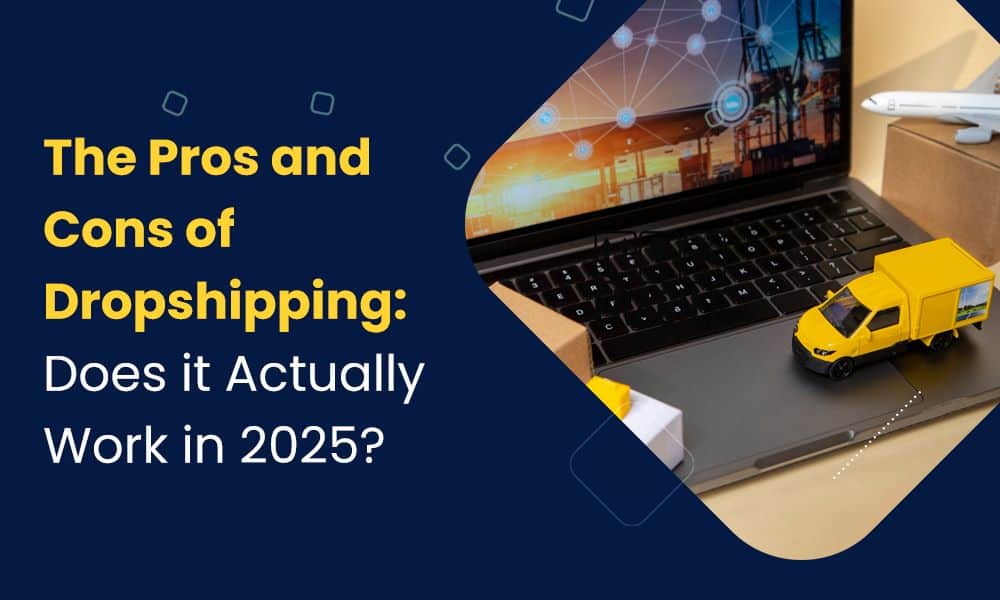I think all of us have at least heard of dropshipping. However, there’s a difference between being familiar with and understanding the term, so what in the world is dropshipping?
It’s a means of order fulfillment where you let a supplier or a third party do it instead of taking care of tasks like procuring and shipping a product yourself.
It’s all about outsourcing these responsibilities anymore, as dropshipping has become an increasingly popular business model in eCommerce. The market continues to dominate, with its global value projected to achieve $301 billion this year.
While dropshipping is hugely advantageous for eCommerce businesses, does that mean it’s right for you? Let’s look at the pros and cons of dropshipping.
Table of Contents
Key Takeaways
- Dropshipping is an advantageous business model for millions of eCommerce brands that want to save money, reduce their risk, and keep operations small (there’s no need for additional staff or warehouse space).
- However, dropshipping reduces your control over the order fulfillment and delivery process, meaning that if your customers complain, there’s usually not much you can do. Further, you can’t personalize your products or packaging as much.
- You must evaluate the advantages and downsides of dropshipping in relation to your personal business goals to make a decision your brand can be happy with.
What are the Pros of Dropshipping
Before we get into any of the negatives, why not start by walking on the bright side and assessing what’s so great about dropshipping? After all, it has its fair share of advantages.
Low initial investment
One of the biggest and most appealing aspects of dropshipping is the possibility of saving money.
Starting an eCommerce business isn’t cheap. You need products or services to sell, then you need to manufacture them. You must also have a platform for selling your products, such as Shopify or Amazon. Those platforms take their cuts and often make you pay additional fees like shipping.
On top of that, you have to pay for marketing and advertising.
It’s no wonder that the startup costs of an eCommerce business have been quoted as high as $30,000! Sure, those are one-time fees, but you still pay several hundred to $3,000 monthly to maintain your business.
By comparison, dropshipping can cost you at least $40 a month. You don’t have to invest thousands or tens of thousands of dollars into dropshipping like you do when starting an eCommerce business from scratch, which is very appealing.
Flexibility and scalability
Yours is a startup eCommerce business venture now, but it won’t remain that way forever. As you begin climbing up the corporate totem pole, you need a business model that will grow with you.
That’s dropshipping in a nutshell.
Let’s compare it to how a typical eCommerce model works. As your business grows, you receive an increasing number of orders. Your fulfillment team must now work much harder to package, prepare, and get those orders out the door.
You can hire more staff, but that can be costly. However, the fulfillment team’s increased workload is unsustainable, so it’s only a matter of time before they burn out and orders begin getting delivered more slowly, if at all.
A dropshipping model works differently. Your supplier, whoever they are, takes care of the fulfillment themselves. That’s less responsibility on you, as you no longer have to determine when to hire more fulfillment staff. You don’t have to hire anyone at all, as a matter of fact.
Your eCommerce business also saves money because you can forego hiring and training more bodies.
Ultimately, the flexibility and scalability of a dropshipping model allow you to pocket more money. You won’t spend extra on fulfillment staff and training, you can save on a dropshipping model compared to a traditional retail model, and scaling up means more sales, thus a healthier bottom line.
Wide product selection
Another undeniable benefit of dropshipping is expanding your product selection.
Let’s go back to the traditional retail model again. The onus is on you to prepare enough warehousing space to handle order fulfillment. If you run out of space, you need to rent or buy more. However, this also comes with the task of hiring additional staff to work at the warehouse.
The alternative is curtailing what you sell to cut down on needed warehousing. This sounds good in theory, as your eCommerce store will appeal to a niche audience, but you’re missing out on many potential customers by selling limited stock.
If the only roadblock is warehouse space, you can switch to a dropshipping model and broaden your product roster. The third-party will secure the warehouse space and sell products, not you, which minimizes inventory risks.
You can work with several dropshippers if needed to stash your growing product stock, allowing you to keep up with customer demand and offer new and innovative products.
Reduced risk
Starting a business is always a risk. Over 93% of today’s businesses have under 20 employees, and up to 12.11% will fail. Only about 24.7% of small businesses last 15 years.
One of the biggest small business risks is going under because of high costs. Some aspiring eCommerce business owners underestimate the prices of starting and maintaining a business, and others manage their finances poorly, putting them in a bad position.
You don’t have to worry about as many fees when you use dropshipping. Once a customer buys a product, you can outsource all the rest to your dropshipper, including fulfillment, shipping, and delivery.
This lowers your financial risk (and elevates your income), reducing the chances of failure.
Work from anywhere
Today, we’re all about that remote life, and that’s also beginning to extend to our professional lives.
More offices have decided to embrace a hybrid or entirely remote schedule, leading to benefits like cost savings, schedule flexibility, higher productivity, and a better work/life balance.
As the owner of an eCommerce brand, you get to make the rules.
That said, following a traditional retail protocol doesn’t leave much room for flexibility in your work schedule. You must be around to oversee operations, or at least not be far away in case you’re needed.
Dropshipping is far more hands-off, as you’re entrusting a large part of the order fulfillment process to a third party. That makes it easier to get your work done from wherever is most prudent, whether that’s your home, a coffee shop, a hotel worldwide, a park, or a beach.
What are the Cons of Dropshipping
If dropshipping is profitable and beneficial, then why doesn’t every business do it, regardless of size?
The nice thing about having business model choices is that we can select the one that works best for our business. Believe it or not, dropshipping doesn’t suit every type of business.
In the meantime, if you proceed with dropshipping, be aware of the following downsides.
Low profit margins
One of the biggest plusses of dropshipping is the potential to increase your profit margins. You should theoretically earn more by spending less on order fulfillment and expanding your products, right?
Not always.
There’s an ongoing pricing war in dropshipping markets. While it varies based on your products, industry or niche, and the business model you use, your profit margins will be between 10 and 30%.
Some sources say your profit margin can explode to upwards of 300%, but that’s not guaranteed. Even if it does happen, there are no promises that your profit margin will remain consistently high.
You won’t have a good profit margin unless your products sell for 10% over wholesale. Offering consistently low prices because you’re trying to eke out a place in the dropshipping market can set up your small business for failure.
Inventory issues and order fulfillment
Dropshippers aren’t perfect. They’re staffed by people, just like you and me, people who get sick, take vacation time, forget to wrap up tasks, and are otherwise prone to mistakes.
When you manage your stock and shipping yourself, you understand what the supply chain looks like and when orders go out from the date they’re ordered.
However, when you rely on a dropshipper to take care of all the heavy lifting for you, sure, you may save time and money, but you remain blind to the day-to-day intricacies of your business.
If interruptions occur, you may be none the wiser (at least at first), but your customers will know. And on that note…
Customer service challenges
A major issue with dropshipping is the propensity for more customer service issues. People may want to know why an item said it was in stock but is now on backorder or why their order that was supposed to ship out two weeks ago hasn’t left the warehouse yet.
When you manage your stock and shipping, you can review the order number to determine where and why it hasn’t moved. You can then prioritize the order so it arrives fast. These are pillars of good customer service, as they keep the customer feeling valued.
But what about if you use dropshippers? Well, the time the order arrives is not something you have control over. You can call the dropshipper to check on the order’s status, but that’s about all you can do.
Your customers might be less than pleased to hear that you can’t do anything about the delivery speed of an order or hasten returns. They might also not like knowing that you’re not directly in control of their orders even though your business is the one they gave their hard-earned money to.
Limited branding and customization
Did you know that 45% of people are more likely to purchase from an eCommerce store with personalization? It matters most to Generation Z, with 74% preferring personalization, followed by 67% of millennials, 61% of Generation Z, and 57% of baby boomers.
Bearing that in mind, you might want to rethink your decision to opt for a dropshipper rather than take care of the shipping and fulfillment responsibilities yourself. You have fewer personalization options when using a dropshipper.
That begins with the products you sell and extends to your packaging. In fact, regarding the latter, you might not even get a say. The dropshipper handles packaging, so they’d probably use their default package options that aren’t branded to your eCommerce store.
The genericism of your products and packages might fail to appeal to prospective audiences, limiting how much money you can earn and possibly impacting the success of your small business.
Dependence on third-party suppliers
I saved the biggest downside of dropshipping for last: your reliance on third-party suppliers.
You’re at their mercy, as ultimately, they’re the ones who will fulfill, package, and ship your orders. So much is at their discretion, from product quality to packaging, shipping speed, and deliverability timeframes.
Your hands are tied if they can’t keep up with demand or run into any slowdowns or supply chain issues. As already established, this can erode customer trust. Maybe they’ll let you slide once, but if you regularly experience delays and slowdowns, your audience will entrust their hard-earned money to a competitor.
Read also: eCommerce In-house Support — Pros and Cons Explained
Comparison with Traditional eCommerce Models
Although dropshipping is increasing in preference and popularity, as the last section proves, traditional eCommerce business models do still have their merits. Here are a few examples so we can compare them to dropshipping.
Traditional inventory modeling requires buying stock from a manufacturer’s warehouse and then selling it to your customers. You take care of picking orders, packaging them, and shipping them.
A full-service warehousing model uses a third party to do all warehousing, including inventory storage, item picking, packing, handling, and shipping.
Stock-and-ship requires you to buy your inventory through a wholesale distributor and purchase large portions. Then, you have the items in stock to ship to your customers.
With so many eCommerce models, how do you choose the right one for your business? Let’s explore!
- If you have large scale products (not necessarily a lot of stock, but big items) and not enough warehouse space, dropshipping is a wise choice.
- Try the full-service warehousing model if you don’t have enough stock to warrant purchasing or leasing warehouse space.
- If your items are heavy, consider dropshipping. You won’t have to shell out for all the additional fees associated with the product’s weight.
- Dropshipping can open up your warehouse space if you have too many items to stock in a warehouse.
- If you want to take care of order production and packaging, you should use a traditional eCommerce model instead of dropshipping.
- If you don’t mind whether your packaging is customized, dropshipping is an appropriate business model.
- If you have a lot of competition in your niche or market, you should not use dropshipping, as you’ll need more control over your packaging and personalization to stand out against the competition.
Read also: eCommerce Automation — How To Automate Your eCommerce Business
3 Real-World Examples of Dropshipping
If your eCommerce business is ready to proceed with dropshipping, the following success stories should certainly inspire you!
1. Toyshades

The eyewear brand Toyshades is a popular eCommerce company born on Shopify. The London-based business has several eyewear collections that it relies on dropshipping to achieve. Created in 2013, Toyshades has a moderate online presence and nothing but rave reviews.
As an eCommerce brand, Toyshades accepts many forms of payment, including Visa Card, PayPal, MasterCard, Google Payments, Discover Card, Apple Pay, and American Express.
Read also: Is Dropshipping Legal? Laws and Regulations for Solopreneurs
2. Little Crystals

Meet Little Crystals, an eCommerce platform specializing in crystal-based jewelry. The founder, Sonia, believes that crystals have healing elements. As a dropshipping-friendly business, Little Crystals also accepts assorted payment options.
Further, the shipping times are between five and 10 days, a standard when shopping with brands that work with dropshippers.
Read also: Dropshipping Basics: A 101 Guide for Small Business Success
3. Beardbrand
This may surprise you, especially since Beardbrand is a well-known men’s beard company. It also uses the dropshipping model.
Still, more than 7,000 five-star reviews can’t be wrong. Beardbrand offers free style consultations and free shipping if you pay $75 or more on your order. You can also switch a product for a different one if you don’t like the original, and Beardbrand doesn’t charge you for it.
Unsurprisingly, when Beardbrand began taking off as a Shopify brand, it raked in more than $100,000 in six months.
Read also: Customer Service for Dropshipping — A Detailed Guide
Conclusion
With more eCommerce businesses opting for dropshipping, your business might be inclined to try the same. However, you should carefully weigh the pros and cons before choosing.
Dropshipping can be the right call for many businesses, but if it doesn’t suit yours, you can always explore hybrid dropshipping or other order fulfillment methods!
EngageBay is an all-in-one marketing, sales, and customer support software for small businesses, startups, and solopreneurs. You get email marketing, marketing automation, landing page and email templates, segmentation and personalization, sales pipelines, live chat, and more.
Sign up for free with EngageBay or book a demo with our experts.
Frequently Asked Questions (FAQ)
1. What are the most common problems faced by dropshipping businesses?
Dropshipping businesses can face many challenges, such as reduced profit margins, less supply chain control, stiff competition, and struggles with branding.
It’s also hard to support your customers when you don’t have a say in when their orders get delivered.
2. How do profit margins in dropshipping compare to traditional retail?
Profit margins for traditional retail businesses hover at 25 to 60%, a marked increase from dropshipping profit margins. They linger between 10 and 20$, although they can be higher.
3. Can dropshipping be combined with traditional stock-and-ship models?
Yes, you can. It’s known as hybrid dropshipping because it has a bit of traditional and modern shipping practices. As the retailer, you will always have at least some stock to ship to customers as they purchase it. However, most of your stock will be at your warehouse.
4. What are the best practices for managing supplier relationships in dropshipping?
You should prioritize open communication and scheduling regular check-ins, such as once a week or every other week. You should also have good conflict resolution, as issues will undoubtedly arise over your working relationship.
5. How can I Improve customer satisfaction in a dropshipping model?
Make customer service a concern for you and the dropshipper. Set up a working arrangement where you can forward customer complaints as they arise so the dropshipper can amend the issue as soon as possible. Aim for short response times and faster shipping speed, if possible.

